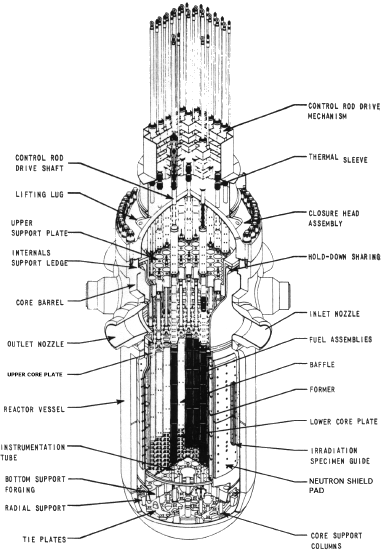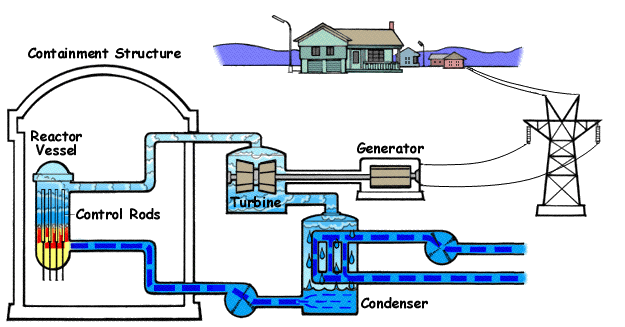 1.3.1 Heat, Water and Steam
1.3.1 Heat, Water and SteamThe Navy's reactor
We have seen how Alvin Weinberg's toy water moderated Low Intensity Test Reactor emulated many features of the natural reactors at Oklo. This was all inadvertent of course, because the Oklo reactors had not yet been discovered. One Oklo feature the Low Intensity Test Reactor did not emulate was the production of steam. So when Weinberg and his staff set out to design a reactor that could be used by the Navy, they had to to design a reactor that could produce steam.
The pressurized water reactor in many respects resembles a boiler. Water contained in pressure resistant tubes, is pumped into direct contact with nuclear fuel pellets. The water serves to both cool the pellets and moderate the nuclear chain reaction. A chain reaction cannot take place with out the presence of water. As as a condition of chain reaction occurs in the reactor, that is the reactor goes critical, fuel elements begin to heat, and indeed they become a great deal hotter than the boiling point of water. Water under pressure does not boil. Thus as water flows through the reactor it heats. In order for water to turn to steam it must expand. But the walls of the tube through which the water flows through the reactor are rigid, hence there is no room for the water to expand into steam. Thus the water is prevented from turning to steam by pressure.
The vapor pressure created by the tendency of the water inside the tubes to boil reaches up too 150 times the pressure of the atmosphere, or 2200 pounds per square inch. This is a tremendous force, and the tubes need to be very strong, or they could explode. One way to do that is to have highly pressurized water pushing back against the outside of the tube. So there had to be heated water surrounding the reactor. But in order to keep that heated water from flashing into steam, it had to be contained in a very strong steel pressure vessel.
The reactor could be controlled internally with neutron absorbing rods, that would be inserted through the top of the Pressure vessel, into the reactor to slow down or stop the chain reaction. On atomic submarines the control rods were used like throttles that could decrease or increase reactor power, and hence heat and steam output. By controlling steam output, reactor operators could control the speed of the submarine.

In the pressurized water reactors, used in nuclear submarines, the water that flows through the reactor is not converted directly into steam. Rather the superheated, pressurized water in the primary coolant system passes through a heat exchange, through which heat passes to another stream of water. The cooled water in the primary coolant system then is returned to the reactor. The superheated water in the secondary coolant system passes into a chamber where itis allowed to expand into steam and then the steam flows to a turbine which drives eother the ships engines, or a generator, depending on the function of the reactor.

A second type of water cooled reactor differs from the Pressurized Water Reactor by allowing steam to form inside the reactor, This Boiling Water Reactor operates at half the pressure that a pressurized Water Reactor does, and therefore at lower temperatures. It is less efficient than Pressurized Water Reactors, however.
We have seen how Alvin Weinberg's toy water moderated Low Intensity Test Reactor emulated many features of the natural reactors at Oklo. This was all inadvertent of course, because the Oklo reactors had not yet been discovered. One Oklo feature the Low Intensity Test Reactor did not emulate was the production of steam. So when Weinberg and his staff set out to design a reactor that could be used by the Navy, they had to to design a reactor that could produce steam.
The pressurized water reactor in many respects resembles a boiler. Water contained in pressure resistant tubes, is pumped into direct contact with nuclear fuel pellets. The water serves to both cool the pellets and moderate the nuclear chain reaction. A chain reaction cannot take place with out the presence of water. As as a condition of chain reaction occurs in the reactor, that is the reactor goes critical, fuel elements begin to heat, and indeed they become a great deal hotter than the boiling point of water. Water under pressure does not boil. Thus as water flows through the reactor it heats. In order for water to turn to steam it must expand. But the walls of the tube through which the water flows through the reactor are rigid, hence there is no room for the water to expand into steam. Thus the water is prevented from turning to steam by pressure.
The vapor pressure created by the tendency of the water inside the tubes to boil reaches up too 150 times the pressure of the atmosphere, or 2200 pounds per square inch. This is a tremendous force, and the tubes need to be very strong, or they could explode. One way to do that is to have highly pressurized water pushing back against the outside of the tube. So there had to be heated water surrounding the reactor. But in order to keep that heated water from flashing into steam, it had to be contained in a very strong steel pressure vessel.
The reactor could be controlled internally with neutron absorbing rods, that would be inserted through the top of the Pressure vessel, into the reactor to slow down or stop the chain reaction. On atomic submarines the control rods were used like throttles that could decrease or increase reactor power, and hence heat and steam output. By controlling steam output, reactor operators could control the speed of the submarine.
In the pressurized water reactors, used in nuclear submarines, the water that flows through the reactor is not converted directly into steam. Rather the superheated, pressurized water in the primary coolant system passes through a heat exchange, through which heat passes to another stream of water. The cooled water in the primary coolant system then is returned to the reactor. The superheated water in the secondary coolant system passes into a chamber where itis allowed to expand into steam and then the steam flows to a turbine which drives eother the ships engines, or a generator, depending on the function of the reactor.

A second type of water cooled reactor differs from the Pressurized Water Reactor by allowing steam to form inside the reactor, This Boiling Water Reactor operates at half the pressure that a pressurized Water Reactor does, and therefore at lower temperatures. It is less efficient than Pressurized Water Reactors, however.
To the Navy the Pressurized Water Reactor looked a lot like a boiler, and boilers were something the Navy understood. By the time the Nautilus first slipped out to sea in 1954, the Navy had been operating ships with boilers for over 100 years. Boilers were potentially dangerous, but the Navy had mastered them, and quickly began to master the reactor as well. As it mastered the reactor, the Navy was to begin to master some unique safety issues.









No comments:
Post a Comment